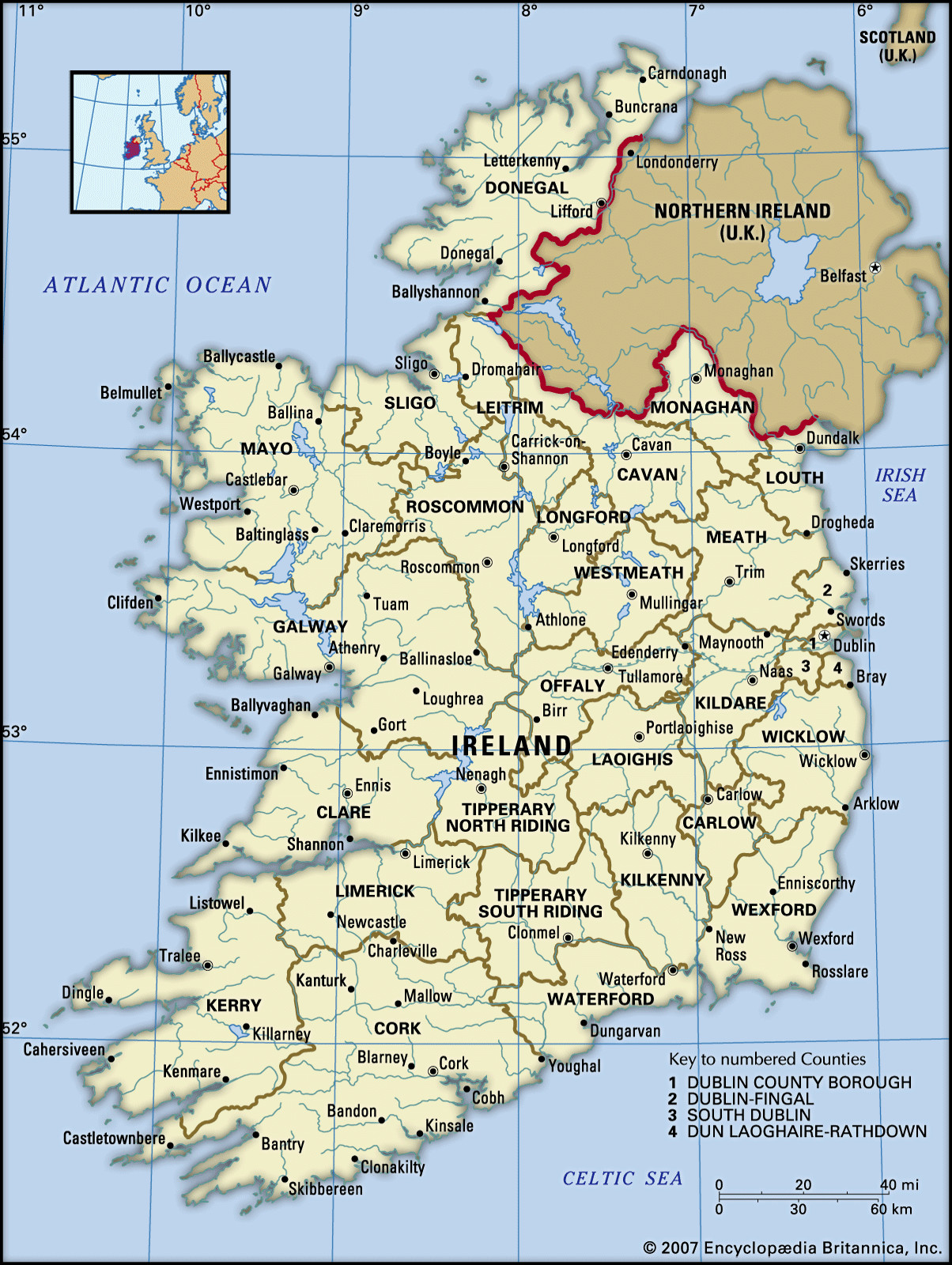Ireland, often referred to as the Emerald Isle, is a land of stunning landscapes, rich history, and vibrant culture. But Where Is Ireland Located exactly? This captivating country is situated in Western Europe, forming part of the British Isles archipelago. Its geographical position has profoundly shaped its history, culture, and unique identity, making it a fascinating destination for travelers and geography enthusiasts alike.
 Detailed map of Ireland showcasing its counties and major cities, highlighting its geographical divisions within the island of Ireland.
Detailed map of Ireland showcasing its counties and major cities, highlighting its geographical divisions within the island of Ireland.
Delving into Ireland’s Geographic Coordinates and Position
To pinpoint where Ireland is located more precisely, we can look at its geographic coordinates. Ireland lies between latitudes 51°30′ and 55°30′ North, placing it at a similar latitude to Labrador in Canada or British Columbia. In terms of longitude, it extends between 6°00′ and 10°30′ West, positioning it as far west as Liberia in West Africa. This westerly location makes Ireland the westernmost outpost of the Eurasian landmass on the Atlantic fringe, with Tearaght Island being its absolute westernmost point.
Ireland is an island separated from Great Britain to its east by a series of bodies of water. The North Channel lies to the northeast, the Irish Sea to the east, and St. George’s Channel to the southeast. These waters, ranging from 11 to 120 miles (18 to 193 km) in width, create a natural separation while also facilitating historical and cultural exchange. To the west, Ireland faces the vast expanse of the Atlantic Ocean, its dramatic coastline stretching for thousands of miles. Geologically, Ireland, like Great Britain, sits on the European continental shelf, surrounded by relatively shallow seas, generally less than 650 feet (200 meters) deep.
 The majestic Cliffs of Moher in County Clare, Ireland, demonstrating the dramatic Atlantic coastline of the country.
The majestic Cliffs of Moher in County Clare, Ireland, demonstrating the dramatic Atlantic coastline of the country.
Ireland’s Place in the European Context
Understanding Ireland’s location also requires considering its broader European context. As part of Western Europe, Ireland is geographically positioned near the European mainland. While it is an island nation, its proximity to the continent has been crucial throughout history, influencing trade, migration, and political dynamics. Ireland is a member of the European Union, further integrating it into the economic and political landscape of Western Europe. It is situated west of the United Kingdom, and across the English Channel from countries like France. This strategic location has made Ireland a bridge between North America and Europe, particularly in modern times with advancements in air travel and digital communication.
Key Geographical Features Shaping Ireland’s Landscape
The physical geography of where Ireland is located is as captivating as its cultural heritage. The country’s landscape is characterized by a central plain, largely composed of limestone, which is encircled by coastal highlands. This central lowland, typically between 200 and 400 feet (60 and 120 meters) above sea level, is dotted with numerous lakes, extensive boglands, and gentle hills. Major mountain ranges punctuate the coastal fringes, including the Blue Stack Mountains in the north, the Wicklow Mountains in the east (home to Lugnaquillia, its highest peak), and the Macgillycuddy’s Reeks in the southwest, where Carrantuohill, Ireland’s highest mountain, stands tall.
The coastline itself varies dramatically. The western and southwestern coasts are wildly beautiful and deeply indented, featuring mountains plunging into the Atlantic, creating dramatic bays like Bantry Bay and Dingle Bay. In contrast, the east coast is smoother, with fewer indentations, yet it serves as the primary gateway for trade due to its closer proximity to Britain and mainland Europe. The characteristic “Emerald Isle” hue is a direct result of Ireland’s pervasive grasslands, nourished by abundant rainfall, contributing to its lush, green scenery.
Conclusion: Ireland’s Unique Geographical Identity
In conclusion, Ireland is located in a unique and geographically significant position in Western Europe. As an island of the British Isles, fringed by the Atlantic Ocean, its location has shaped its climate, landscape, and history. From its precise coordinates to its broader European context, understanding where Ireland is located provides a crucial foundation for appreciating the rich tapestry of this enchanting country. Its stunning scenery, from dramatic coastlines to verdant plains, coupled with its westerly European position, makes Ireland a truly special place on the world map, inviting exploration and discovery.

